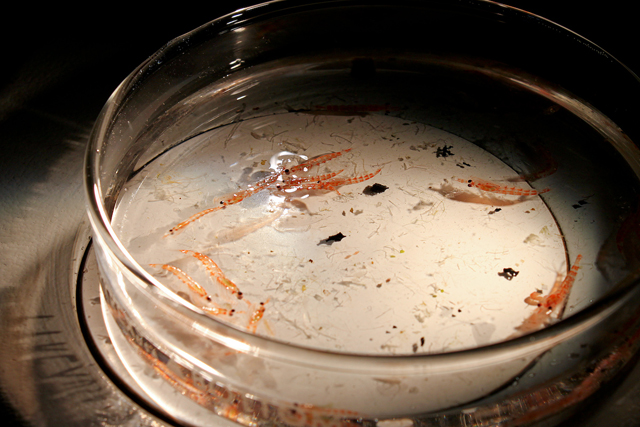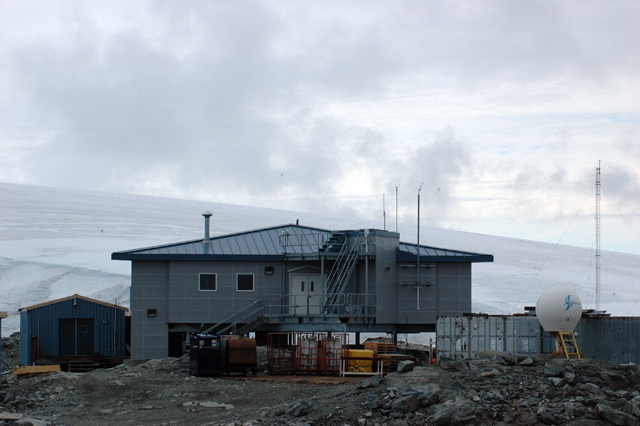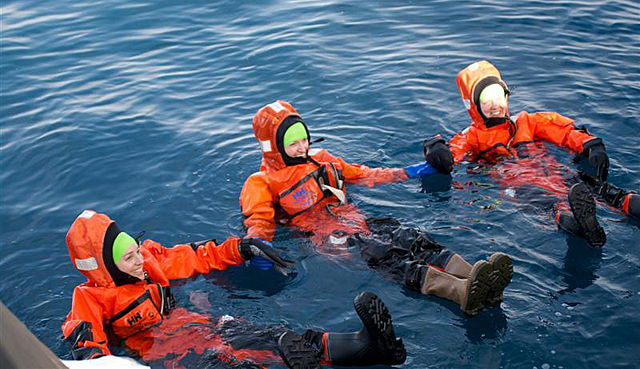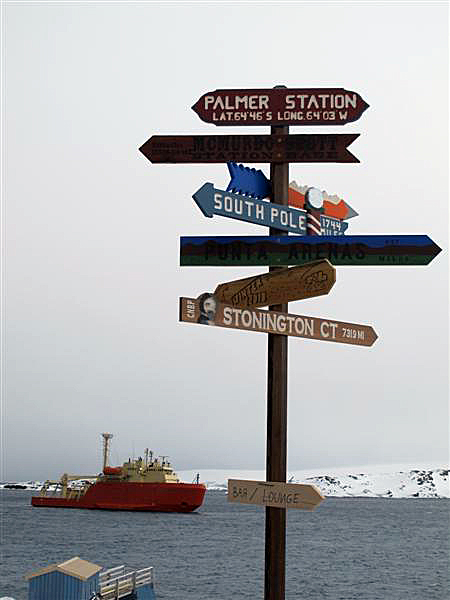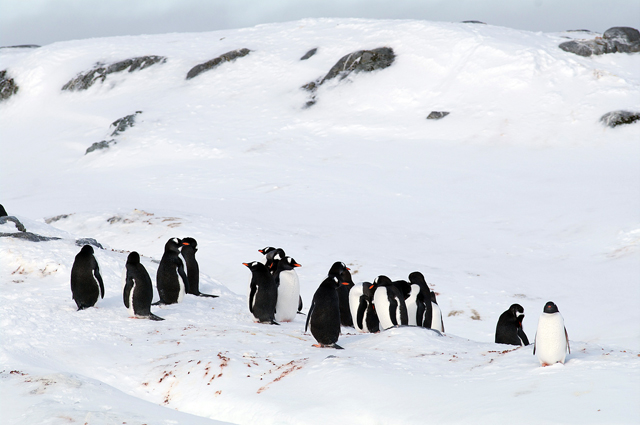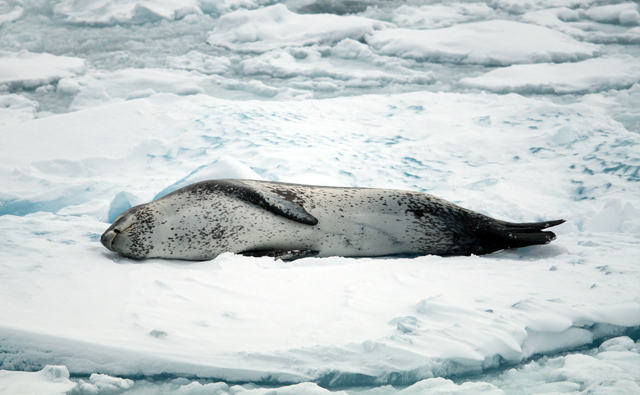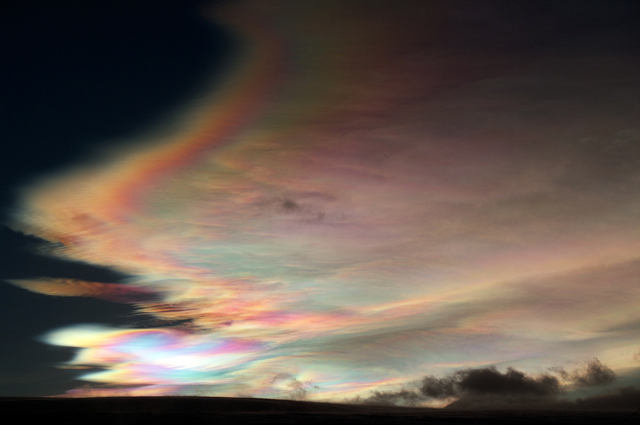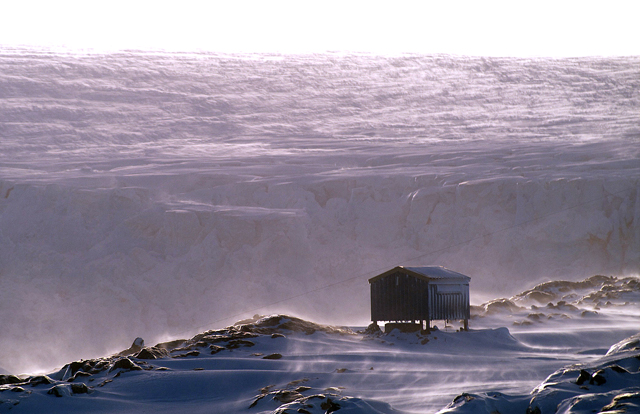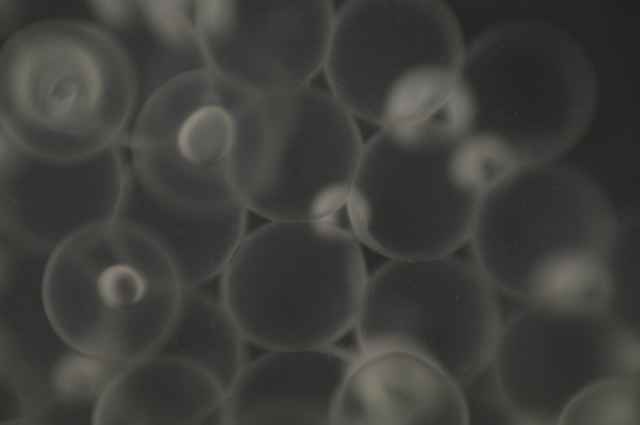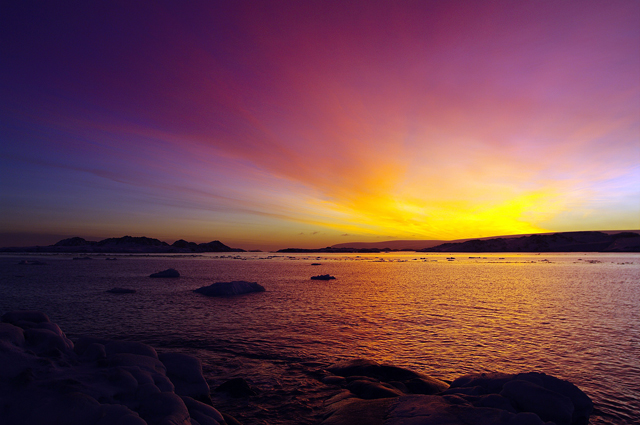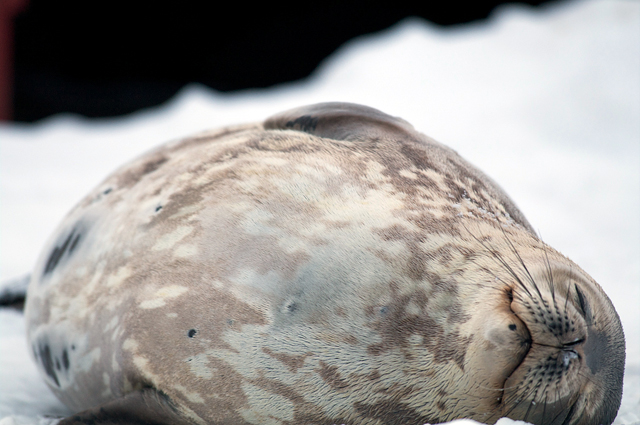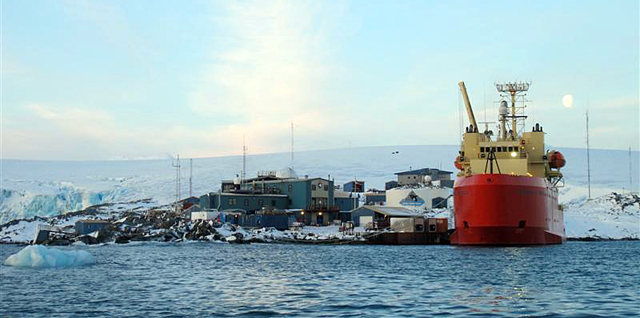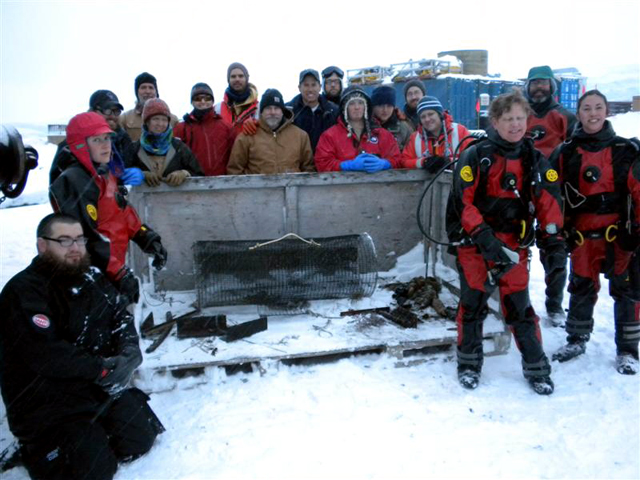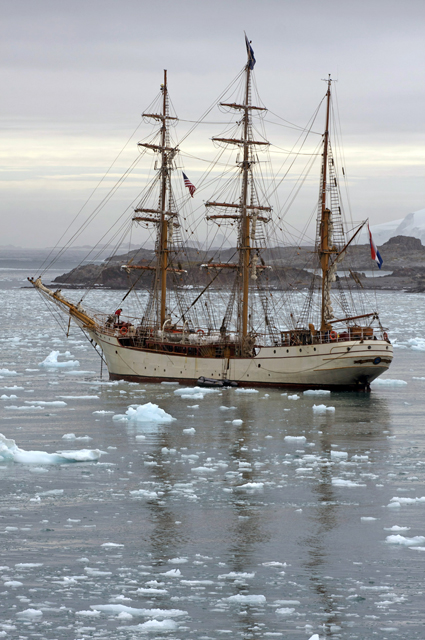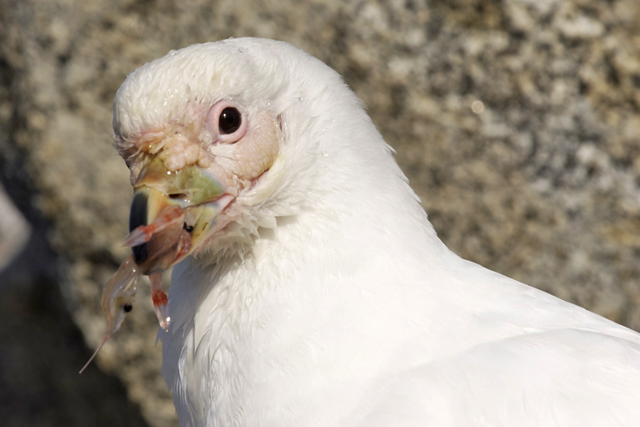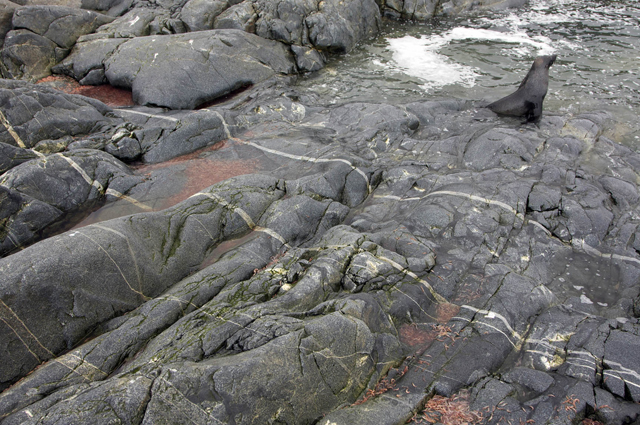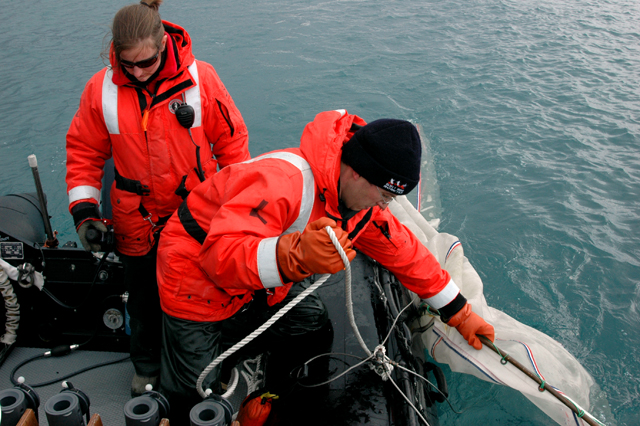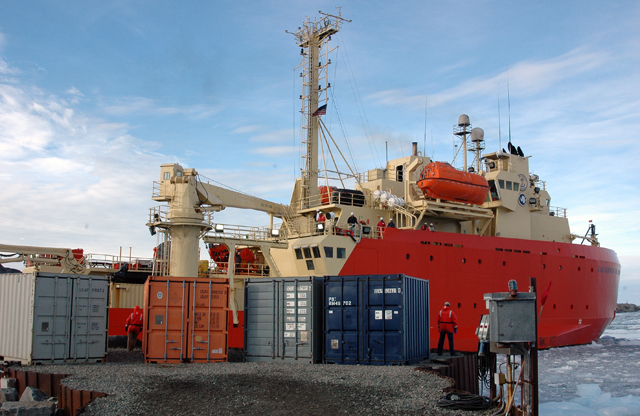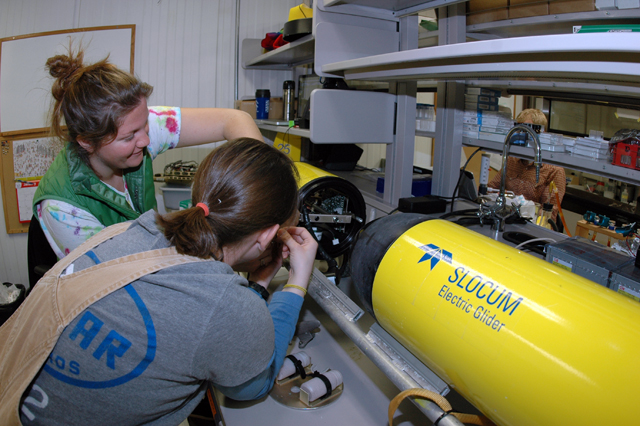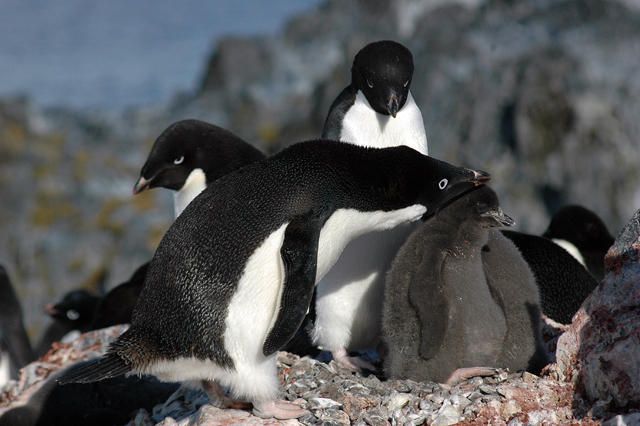|
Palmer Station Archives - 2010 First visitors of summer season make port call at Palmer StationPosted December 10, 2010
In describing Palmer Station October’s mad weather continued into November, barely losing steam through a busy port call that doubled the local population and had us all running. Since the hasty northbound departure of the research vessel Laurence M. Gould Prior to the port call, preparations were being made on station by an expanded waste team for the biannual hazardous waste run. Led by Raytheon Polar Services’ 
Photo Credit: Andrew V. Williams/Antarctic Photo Library
The research vessel Laurence M. Gould docks at Palmer Station.
Normally, the Gould would take the hazardous waste directly back to the United States, but this year it will be loaded onto the research vessel Nathaniel B. Palmer Before reaching Palmer Station on its most recent transit, the Gould stopped to quickly and successfully open Cape Shirreff field camp in the northern reaches of the Antarctic Peninsula on Livingston Island. Five scientists will spend the austral summer there studying Antarctic fur seals. [See previous article: Keeping track.] The port call itself, in addition to the hazardous waste management, included several other temporary visitors. The National Science Foundation A new science group had two members here to install new equipment in Terra Lab. The principal investigator, Qian Wu, with the help of Andrew Watt, installed a Fabry-Perot Interferometer that will provide wind and temperature information from the mesospheric and thermospheric layers of Earth’s atmosphere. In collaboration with scientists and similar instrumentation at Australia’s Davis and Mawson Two other new science events arrived on station this month, both investigating viruses. Under Grieg Steward, a team is here to study the effects of viruses on the local phytoplankton population. Data collected by the Palmer Long Term Ecological Research A second project is the post-doctorate work for Jennifer Brum. Brum will be studying different styles of virus reproduction and how they relate to various annual cycles of the Palmer area ecosystem. The final weeks of November brought two visiting ships to station. The Chilean Navy vessel Lautaro had the honor of being our first visitors of the summer season. The Lautaro supplies the Chilean Antarctic research stations and collects bathymetric data around the Antarctic Peninsula. They brought beautiful weather with them, and after touring Palmer Station, they invited us to a barbeque on the deck of the Lautaro. The first commercial cruise visit, on Thanksgiving Day, was the National Geographic Explorer, bringing more than 100 guests to tour the station. One of the Explorer’s divers, Lisa Trotter, also served as Palmer Station’s winter site manager from April through September of this year, so it was great to welcome her back, if only briefly. [See previous article: Diving in.] First summer science teams arrive at Palmer StationPosted November 5, 2010
The summer science season is slowly ramping up at Palmer Station In this first month of summer, Palmer has been pummeled by wind, snow, sleet and rain. We’ve seen hours-on-end of sustained 50-knot winds, gusting into the 80s, approaching the maximum recorded wind speed of 93 knots. The wind and rain have stripped the area of nearly all its snow and turned the short road through town into an icy, slushy mess. But it was better to be at Palmer than on the research vessel for the northbound leg of its recent transit. The high wind and waves in the Drake Passage provided a miserable crossing for much of the outgoing winter crew on the Laurence M. Gould The Palmer Long Term Ecological Research (PAL LTER) In the few days that were calm enough for boating, the scientists made their first krill catch: a meager 20-or-so juveniles of the shrimplike animal. They also made their first water column sample collections at Station E, a location of long-standing record nearly two miles away from Palmer. Station E is known for beautiful views back toward Anvers Island on nice days, and notorious for foul swell, chop and seasickness on anything less than a nice day. A new research group is on station for a month to study the long-range atmospheric transport of chlorinated organics such as DDT. This work follows the discovery of trace amounts of these compounds in Adélie penguin tissues. A paper on the finding was published online in 2008 in the journal Environmental Science & Technology. [See previous article Persistent chemical.] Scientist Jenna Luek has been collecting samples of air and snow, and hopes to snag some glacial meltwater, now that the base of the nearby glacier has been exposed. The samples will be used to determine sources and sinks for chlorinated organics. Rebecca Dickhut Palmer Station’s generators received some much-needed attention this month. Generator #1 had been unable to take a full load all winter due to a new, but faulty, injector pump. With that repaired, power plant mechanic Dennis Calhoun was able to completely rebuild generator #2. The normally soothing hum of instrumentation at Terra Lab has been accented this month with the harsh but satisfying sounds of construction. On the inside of the earth sciences laboratory, a darkroom has been built to house a new instrument. On the outside, a new enclosure will provide a view of the sky to the darkroom. A timely break in the weather provided the perfect opportunity to slice through the metal skin of Terra Lab’s roof and seal the enclosure in place. The weather window for this construction project came just in time, as a science group led by Qian Wu from the National Center for Atmospheric Research We are looking forward to a busy port call of the Gould in early November that will serve as our hazardous material run for waste that requires special handling and disposition. The visit will also include a few brief science events and some station personnel turnover. We are also crossing our fingers and looking forward to better weather. Summer crew arrives at Palmer StationPosted October 15, 2010
Summer is now in full swing at Palmer Station The LMG also brought fresh food, supplies, and the station’s generator fuel for the upcoming summer season of science. 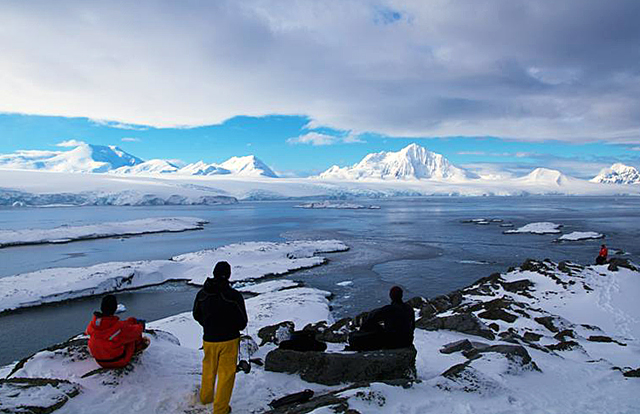
Photo Credit: Sean Bonnette
Palmer Station personnel view Anvers Island from another island. Mount William is in the background to the right.
Most of the incoming crew worked the previous summer season, so turnover of duties went off without a hitch. Everyone came together to offload all the cargo from the ship, adapting to their jobs like they had never left station. Transferring fuel to Palmer from the LMG involves just about everyone working together to set up, monitor, and take down all the equipment needed. It’s mostly an all-day affair. Before fueling can begin, steps must be taken to ensure the containment of any potential spills, either from the LMG or at Palmer. A containment boom is put into place around the ship, along with absorbent rolls placed on deck to stop the spread of any spills. On the station side of the operation, all snow is removed from around the fuel line, which is monitored during fueling. On the fuel line from the LMG there are several clamps in place ready to seal off the line in the event of a puncture. Thanks to all the hard work and preparation put into station fueling, there were no spills and the transfer was very successful. Before the LMG could depart, the station emergency teams needed to turn over duties from the winter to the summer crew. The various emergency teams on station include Glacier Search and Rescue, Ocean Search and Rescue, and Trauma and Fire. Of all these groups, the fire team had the most intensive turnover during the port call, including a fire drill after the winter crew handed over their gear. After a short trip to make conductivity, temperature and depth (CTD) measurements of the water column, the ship made its way north back to Punta Arenas, Chile. Just after untying the LMG, station personal jumped off of the Palmer pier into the frigid water in the polar tradition of farewell, wishing their co-workers and friends a safe trip north. Wildlife returns to Palmer station as summer thaw beginsPosted September 17, 2010
The winter at Palmer Station Over the past month the sea ice has come and gone a few times. Most of what continues to accumulate in the waters around Palmer doesn’t add up to more then rounded pancake ice. Some icebergs have been observed off to the west, but they mostly continue to stay clear of the immediate area. The coming and going of the sea ice has made for increased boating opportunities around the station for search and rescue training, as well as recreation. Soon most of the nearby islands around the station will be off-limits due to the return of the wildlife and seabird breeding. The critter count around station continues to increase each day, with more seal sightings, along with the return of some penguins and other birds. Several small groups of 20 or so gentoo and Adélie penguins have been spotted on local islands. Several groups of gentoo penguins have also been encountered while out boating. This gives those lucky enough to be there a good view of how quickly the penguins move as they porpoise through the water. The number of leopard seal sightings is also on the rise, some as close as the station’s seawater intake pump house. Most are seen in the water fishing or catching some sleep on an ice floe. Social activities on station continue with concerts, art shows, and themed nights in the station lounge area. One of the biggest events in August was a four-band concert. The music ranged from fun covers of punk songs to acoustic Metallica songs to a mandolin cover of “Spiderman” by the Ramones. The station art show consisted mostly of photos taken by the station personnel, but there were also some woodwork and mechanical creations. Pictures ranged from cities to seals to tropical islands. Also on display were the “not quite perpetual motion machine” and a hand-crafted sushi tray. In just a few weeks, the winter season will be coming to an end at Palmer. There will be freshies (fresh vegetables and fruits) once again, the station will be fueled, and there will also be fresh faces. Wildlife returns to Palmer station as summer thaw beginsPosted September 17, 2010
The winter at Palmer Station Over the past month the sea ice has come and gone a few times. Most of what continues to accumulate in the waters around Palmer doesn’t add up to more then rounded pancake ice. Some icebergs have been observed off to the west, but they mostly continue to stay clear of the immediate area. The coming and going of the sea ice has made for increased boating opportunities around the station for search and rescue training, as well as recreation. Soon most of the nearby islands around the station will be off-limits due to the return of the wildlife and seabird breeding. The critter count around station continues to increase each day, with more seal sightings, along with the return of some penguins and other birds. Several small groups of 20 or so gentoo and Adélie penguins have been spotted on local islands. Several groups of gentoo penguins have also been encountered while out boating. This gives those lucky enough to be there a good view of how quickly the penguins move as they porpoise through the water. The number of leopard seal sightings is also on the rise, some as close as the station’s seawater intake pump house. Most are seen in the water fishing or catching some sleep on an ice floe. Social activities on station continue with concerts, art shows, and themed nights in the station lounge area. One of the biggest events in August was a four-band concert. The music ranged from fun covers of punk songs to acoustic Metallica songs to a mandolin cover of “Spiderman” by the Ramones. The station art show consisted mostly of photos taken by the station personnel, but there were also some woodwork and mechanical creations. Pictures ranged from cities to seals to tropical islands. Also on display were the “not quite perpetual motion machine” and a hand-crafted sushi tray. In just a few weeks, the winter season will be coming to an end at Palmer. There will be freshies (fresh vegetables and fruits) once again, the station will be fueled, and there will also be fresh faces. July storms pile up the snow at Palmer StationPosted August 20, 2010
For a month in the middle of winter at Palmer Station One of the biggest events was the Fourth of July celebration, which included a barbecue in the station bar. Hamburgers, pasta salad, bratwursts, hotdogs and their vegetarian alternatives made for a meal as standard as any Independence Day celebration stateside, even if there was not a single firework in the sky to go with it. Even without the fireworks, the music-filled, decorated venue made for a great party. July also brought with it the first sightings of polar stratospheric clouds of the winter. The clouds, also called nacreous clouds, form when the temperature in the polar stratosphere drops below minus 78 degrees Celsius at altitudes between 15,000 and 25,000 meters. Due to the high altitude of the clouds, they tend to receive and reflect sunlight from below the horizon for several hours before sunrise and several hours after sunset. This results in brightly colored clouds lighting up the dark sky while the sun is nowhere to be seen. Construction for the installation of an interferometer has begun in TerraLab, a triangular science building home to about a dozen ongoing geophysical experiments. In order to install the interferometer, a new room had to be built and a cut made in the roof. The room will be constructed during the winter, with the roofing hole and interferometer installations to follow this summer. Scientists use the interferometer to study airglow in the Earth’s atmosphere. Airglow prevents even the best ground-based observatories from observing the much fainter objects that a space-based observatory like the Hubble Space Telescope can see at visible wavelengths. About mid-July, sea ice started to form in the Palmer area, which makes boating to local islands impossible. This makes the glacier behind station the main area for outdoor recreational activities. The snow on the glacier finally accumulated enough to make skiing and other winter sports more viable than during previous months this year. After a snowstorm near the end of July, the snow measured 139 inches. The heavy snowfall, combined with high winds, left many snowdrifts around station, some taller than most of the station’s personnel. Some areas are almost impossible to clear out. As soon as the snow is shoveled away, the wind drives it back, almost as deep as it was before. This can make travel between buildings difficult by clogging walkways and keeping doors from opening. During snow dumps like these, the station winter-overs can find themselves shoveling and moving snow almost as much —or more so — than doing their regular jobs. But keeping the station clear of snow is part of the teamwork that makes working at Palmer special. July storms pile up the snow at Palmer StationPosted August 20, 2010
For a month in the middle of winter at Palmer Station One of the biggest events was the Fourth of July celebration, which included a barbecue in the station bar. Hamburgers, pasta salad, bratwursts, hotdogs and their vegetarian alternatives made for a meal as standard as any Independence Day celebration stateside, even if there was not a single firework in the sky to go with it. Even without the fireworks, the music-filled, decorated venue made for a great party. July also brought with it the first sightings of polar stratospheric clouds of the winter. The clouds, also called nacreous clouds, form when the temperature in the polar stratosphere drops below minus 78 degrees Celsius at altitudes between 15,000 and 25,000 meters. Due to the high altitude of the clouds, they tend to receive and reflect sunlight from below the horizon for several hours before sunrise and several hours after sunset. This results in brightly colored clouds lighting up the dark sky while the sun is nowhere to be seen. Construction for the installation of an interferometer has begun in TerraLab, a triangular science building home to about a dozen ongoing geophysical experiments. In order to install the interferometer, a new room had to be built and a cut made in the roof. The room will be constructed during the winter, with the roofing hole and interferometer installations to follow this summer. Scientists use the interferometer to study airglow in the Earth’s atmosphere. Airglow prevents even the best ground-based observatories from observing the much fainter objects that a space-based observatory like the Hubble Space Telescope can see at visible wavelengths. About mid-July, sea ice started to form in the Palmer area, which makes boating to local islands impossible. This makes the glacier behind station the main area for outdoor recreational activities. The snow on the glacier finally accumulated enough to make skiing and other winter sports more viable than during previous months this year. After a snowstorm near the end of July, the snow measured 139 inches. The heavy snowfall, combined with high winds, left many snowdrifts around station, some taller than most of the station’s personnel. Some areas are almost impossible to clear out. As soon as the snow is shoveled away, the wind drives it back, almost as deep as it was before. This can make travel between buildings difficult by clogging walkways and keeping doors from opening. During snow dumps like these, the station winter-overs can find themselves shoveling and moving snow almost as much —or more so — than doing their regular jobs. But keeping the station clear of snow is part of the teamwork that makes working at Palmer special. Palmer residents dig into midwinter feastPosted July 9, 2010
June brought the biggest social event of the season to Palmer Station June 21 marks the winter solstice and the shortest day of the year in Antarctica. Traditionally, since the days of the early explorers, midwinter is one of the high holidays on the Ice. The main highlight is the midwinter feast. At Palmer, station chef Keith Reimink prepared such dishes such as bacon-wrapped scallops, tossed green salad, creamy pumpkin soup, stuffed-beef tenderloin and crab legs, with a baked apple dumpling dessert. The whole celebration was really a station-wide effort. Some people helped in the preparation of the food, others in setting up decorations. It really was enjoyed by the 18 of us wintering here at Palmer. One person on the winter crew includes a science grantee, a member of Bill Detrich’s Even though the embryos won’t get a chance to hatch on station, Detrich’s crew still hopes to learn more about the fish by observing the growth and multiplication of cells over the coming months. Station personnel have also been busy training on one of several emergency-response teams. Because of the small population at Palmer, most personnel are on multiple emergency teams. At Palmer, like any other remote location, we are our own first-responders, so we really need to be able to help ourselves. That’s especially true for the trauma team, with just one doctor on station. In an emergency, there is no way that just one person could do it all, so there are a few people being trained to assist in medical procedures. The training so far has included basic patient assessment in the field, back-boarding, and even how to start an IV. In addition, there are also glacier search and rescue, ocean search and rescue, and fire teams. Each group of volunteers meets at least once a month to hone their current skills, and to learn and practice new ones. The weather at Palmer has been varied over the past month — from days with winds gusting over 60 knots with blowing snow to days without a cloud in sight and very negligible wind. Small icebergs have been entering the Palmer area and grounding themselves on the shallow seafloor, only to disappear after particularly windy days. Some of the bergs look as if they could almost become additional islands themselves because they hang out in the area so long. Aside from the big bergs, a few critters have been spotted near the station, though most of the wildlife has left for the winter. The station has been visited by a few penguins, fur seals and even a Weddell seal. The winter season is well underway. Projects continue forward, teams continue to train, and the snow continues to blow in the wind — reminding us that, yes, this is really winter. Stormy weather hits Palmer as winter settles inPosted June 18, 2010
The winter season has finally kicked in here at Palmer Station With the departure of the Gould, station population is now down to 18, including one remaining member of Bill Detrich’s Also departing on the Gould was the science group led on station by Charles Chuck Amsler and Jim McClintock As science wrapped up for the long summer season at Palmer Station, support personnel attended to various projects. During the last month, the toilets were switched over from saltwater to freshwater, and some monitoring took place on the waste system. This information will be used to determine the size of any future wastewater treatment here at Palmer. During one particularly nasty storm at Palmer, wind ripped the pier bumpers from their attachment points. One of the jumbo bumpers had floated down Hero Inlet while a single, tangled chain held the other bumper from blowing away. Station personnel and the science divers made repairs and returned the bumpers to their place at the pier, allowing the Gould to return from its last scientific fishing trip of the year. The research vessel Nathaniel B. Palmer The last night that the Gould was in port, station personnel hosted an open mic night. There were several musical performances by station personnel, ranging from blue grass to piano covers of the Super Mario Bros. theme song. Others recited poetry, and one person demonstrated yodeling. With the Gould gone until September, Palmer Station is now in the very skilled and capable hands of the winter crew. Palmer Station swaps out crews, participates in Earth DayPosted May 14, 2010
Palmer Station The majority of the winter-overs arrived at station on April 16 aboard the ARSV Laurence M. Gould Station turnover took place over a short period of about eight days. In that time, the Gould offloaded about 60,000 gallons of fuel for the station generators, along with the main winter-food order. Also, during this time, the summer crew handed over all of the station emergency team duties to the winter-overs. Shortly after the fire teams turned over, the winter crew got its first test beyond the normal training drill with a real emergency at the power plant. Generator problems forced the power plant mechanics to switch power to the emergency generator. While work was under way to fix the main generators, someone spotted smoke at the emergency power plant. But thanks to the quick action of the first responders and fire teams, the fire didn’t get the chance to spread past the top of the engine block and caused minimal damage. Shortly after the fire, the mechanics fixed one of the generators at the main power plant, with power being lost to the station for only a short time. During this time, with the Gould docked at the pier, the U.S. Antarctic Program’s Still on station for the next month is a group of science divers from University of Alabama at Birmingham and University of South Florida. [See project blog: UAB in Antarctica Some of the trash recoved included a AA battery, an old fishing trap, and a few pieces of metal. Overall, the clean-up was deemed a success. The divers noted that the ocean floor at the base of the pier has improved with each Earth Day dive, as they find less rubbish every year. Palmer Station prepares for transition into winterPosted April 16, 2010
Seasons are changing at Palmer Station Snow is common again, as temperatures are back below freezing, so we’ve placed flags to denote the corners of building and stairs that will be buried under the winter snowpack. Visiting tourist cruise ships are a thing of the past, as are sailboats and chartered yachts. The neighborhood seems very quiet without so much traffic around. The final visitor of the summer season was a tall ship, a unique visit in the station personnel’s collective memory. The barque Europa visited for an evening, sitting elegantly in the harbor with its three masts and elaborate rigging. Most of us toured the ship and stayed for dinner, while the ship’s passengers did the same at Palmer. Stories of sails and high seas told in the cramped quarters aboard the Europa were a good reminder of what Antarctic adventure was like less than a century ago. Our newest science group, with co-principal investigators Chuck Amsler and Jim McClintock and Bill Baker Both of the U.S. Antarctic Program’s 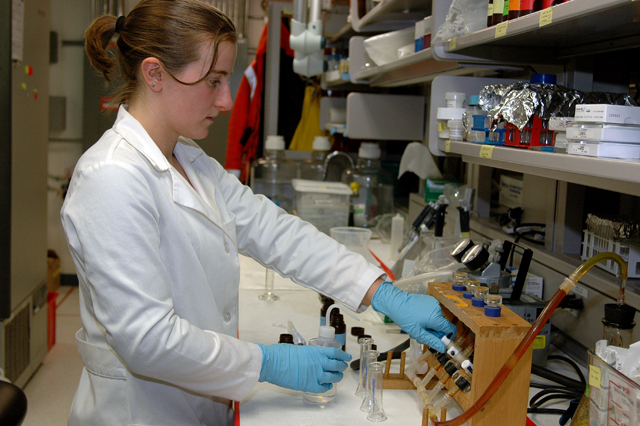
Photo Credit: Peter Rejcek
Alice Alpert processes water samples for Hugh Ducklow's microbes team in one of the Palmer Station labs.
When the Gould departed for its return across the Drake Passage to Punta Arenas, Chile, it took with it the last remaining members of the three LTER science groups. The birders, under principal investigator Bill Fraser Roberta Marinelli, the Antarctic Organisms and Ecosystems As a farewell celebration for the first wave of departing summer crew, we held a second Palmer Open Mic Night of the season. A wide variety of talent took to the stage for more than three hours of entertainment. Spoken performances included readings of short stories and poems, including an original two-act, radio-style crime drama based around station-specific puns. Musical acts included combinations of the accordion, drums, guitar, mandolin, piano and banjo. The evening finished with a set from the Palmer Band, with members of the community and the Gould sitting in for almost every song. Three antenna riggers were also at Palmer in March, updating and fixing the rigging on nearly every antenna around station. They also installed the new Palmer webcam on a radio tower high over station. Not that many years ago, almost all communication off continent involved a ham-radio patch, and now Palmer will be visible to anyone with an Internet connection. New in the neighborhood for the last few weeks has been an iceberg grounded near the station. It’s about the size of a city block, with sheer sides and a smooth top. The massive ice somehow perfectly catches the morning light, disappears into an afternoon snow squall, or has the full moon centered above it at night. So for now, the snow continues to fall and the days shorten. Most of the station’s remaining summer crew will leave in April when a fresh group comes in for the winter months. Projects are wrapping up, and everyone is dreaming of warmer locations. Days grow shorter but summer lingers at Palmer StationPosted March 12, 2010
February has been a busy month around Palmer Station Co-principal investigators (co-PI) Chuck Amsler and Jim McClintock The seven members of the group split their time between the lab and dive sites around Palmer collecting specimens to study. McClintock, Amsler, his wife Maggie Amsler and Bill Baker A different group of divers departed station the middle of February. Underwater photographer Norbert Wu They eagerly collected both video footage and still photography of marine creatures, such as humpback whales, leopard seals, krill and a wide variety of fish. Some small specimens were brought back from the depths to an aquarium for detailed photography and viewing by the station population. The month began with the return of the 17th annual Palmer Long Term Ecological Research (PAL LTER) Working off the ship, two members of Bill Fraser’s seabird research team spent a week studying a massive Adélie penguin population on Avian Island south of Palmer Station. And for a second year, the “birders” landed on ice-choked Charcot Island, even farther to the south, to visit its cliff-side rookery. After just one final night tied up at the Palmer pier to pack and organize, the PAL LTER scientists headed back north to Punta Arenas to conclude this year’s science cruise. The most surprising February visitors arrived in an unusual way for Palmer Station. Five scientists from the LARISSA (LARsen Ice Shelf System, Antarctica) After the British plane dropped off the glaciologists, the Gould shuttled them from Palmer Station to the awaiting RVIB Nathaniel B. Palmer A small ship from the Chilean Navy visited Palmer for a day in the midst of its bathymetric work in the area to map the seafloor. Half of the 50-person crew visited station and stayed for dinner, while a group from Palmer later visited the ship. The ship was familiar because it’s often tied up near the U.S. Antarctic Research Program’s Tourist ships continued to visit Palmer, including the MY Hanse Explorer, which brought Microsoft Chairman Bill Gates and his family to the research base, where he had lunch with station personnel. The weather in February hit wide extremes, with days of strong wind and rain balanced by others of sunshine and calm. One period of wind stranded thousands of krill in tide pools, providing an easy meal for seals and birds. High numbers of krill have also attracted a number of feeding humpback whales to the area. While South Pole and McMurdo Palmer Station supports big science on small crittersPosted February 5, 2010
The animal density around Palmer Station But for the last month there has been a group researching the opposite of this megafauna so often associated with Antarctica. Despite what one would expect, the largest land creature on the continent is a tiny, wingless midge named the Belgica antarctica that ekes out its existence on islands around the Antarctic Peninsula. 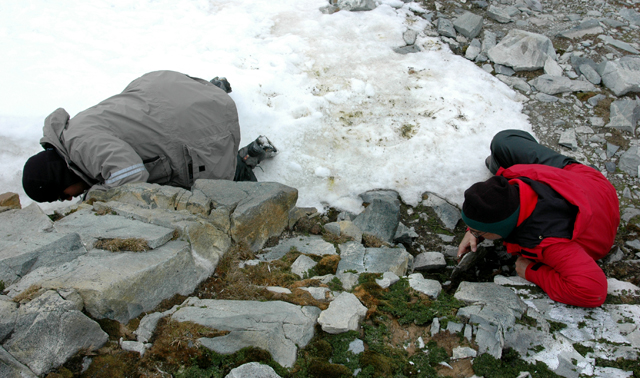
Photo Credit: Peter Rejcek
Scientists Yuta Kawarasaki and David Denlinger search for Belgica antarctica on Humble Island.
The bug has amazing capabilities, such as the ability to lose up to 70 percent of its usual mass to survive the winter season by avoiding the damage caused by freezing. They exist as larvae for two years before briefly maturing into adults during a 10- to 14-day window to reproduce. Rick Lee from Miami University Substantially larger than Belgica, but still quite small, krill are one of the key species in the Antarctic food web. Jonathan Cohen from Eckerd College He conducts experiments to determine what colors of the spectrum they see best to understand how they find food while avoiding predators, among other behaviors. Cohen is often out in an inflatable Zodiac boat, dragging a net in search of the elusive bigeye krill (Thysanoessa macrura), one of the three types of krill in Antarctic waters, and the least studied. During the month of January, scientists on the Palmer Long Term Ecological Research Life on station has also been eventful in January. Palmer’s population peaked at its maxim of 45 people, meaning that the whole group hardly fits together in one room. It’s necessary to show up early and fight for a seat at the weekly science lectures. Recent lecture topics have included mapping Antarctic penguin nesting locations from space, and research involving monk seals and nesting seabirds in the distant atolls of Hawaii. On New Year's Eve, our full population crowded into the lounge for a dance party with live music provided by the station's volunteer band. 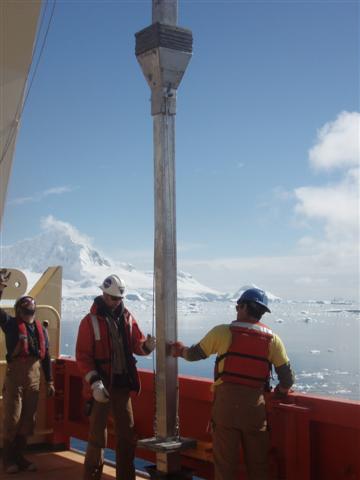
Photo Credit: Adam Jenkins/Antarctic Photo Library
Crew aboard the RVIB Nathaniel B. Palmer handles a sediment-coring instrument.
Well-known underwater photographer Norbert Wu A wide variety of ships visited throughout the month. Several small sailing yachts spent the night tied up in the harbor and enjoyed an opportunity to tour the station. The RVIB Nathaniel B. Palmer Larger cruise ships stop by about once a week with loads of curious passengers. The National Geographic Explorer even visited with Buzz Aldrin, who eagerly compared life at a small Antarctic research station with going to the moon and his dreams of future human trips to Mars. One of the rare perks of working at Palmer is that a guest astronaut occasionally trumps the usual visits by penguins and whales. Ship traffic increases at Palmer Station as summer work peaksPosted January 8, 2010
The ARSV Laurence M. Gould Ross MacPhee David Barbeau Finally, Joseph Kirschvink Ice largely prevented the Gould from gaining access to islands, and late season snow cover proved disruptive to investigating the geology onshore, but all three teams reported successes with their research time. On station, the fellowship of visiting journalists finished their three-week experience through hands-on scientific research. Scott Canon, Jason Orfanon and Angela Posada-Swafford took every opportunity to join in the routines of the science community, helping with all tasks from bird counts to water sampling and lab work. On their final night, the three presented their own science lecture explaining the successes and learning moments achieved over the course of their stay. Overall, they had an increased respect and understanding for the complexity of the environmental research happening at Palmer and the benefit of long-term data sets. The team for Oscar Schofield They brought three remote-operated underwater gliders with them this season that have all “flown” successfully while gathering good data about ocean properties. The deep glider even discovered an underwater trench was far deeper than expected while in its automated up-and-down routine. A second glider was deployed at the beginning of the season’s first phytoplankton bloom, documenting the change in the marine environment. One glider will also deploy during the LTER cruise south of Palmer Station. Bill Fraser’s “birders” group announced the first Adélie penguin chicks on nearby Humble Island in the middle of December, followed soon thereafter by chicks on Torgersen Island. The group will also be active on the LTER cruise looking mainly at several large penguin nesting locations. As we enter the height of summer, cruise ship visitors are more common, bringing people to Palmer from around the globe. They enjoy tours that include an introduction to the science performed here and a sampling of life at an Antarctic research station. One visiting group, part of an Abercrombie & Kent trip organized by longtime Antarctic researcher Jim McClintock, donated a new irradiance meter to the LTER program. It measures the amount of light present for a specific period of time so that researchers can adjust their data for light variations. This radiometer was presented in a ceremony to Alex Kahl, the expedition leader for the phytoplankton group using the gliders out of Rutgers University Around Palmer, the snow pack rapidly vanished in December, mostly thanks to above-freezing temperatures and a steady wind. A few days of rain helped — an un-Antarctic seeming type of weather. The skies cleared for the holidays, providing good boating and hiking opportunities before a Christmas feast and festive gift exchange. |
Home /
Around the Continent /
Palmer Station Archives - 2010
"News about the USAP, the Ice, and the People"



For USAP Participants |
For The Public |
For Researchers and EducatorsContact UsU.S. National Science FoundationOffice of Polar Programs Geosciences Directorate 2415 Eisenhower Avenue, Suite W7100 Alexandria, VA 22314 Sign up for the NSF Office of Polar Programs newsletter and events. Feedback Form |

